Design Philosophy 1

Sound Box Geometry and Architecture
Thursday, September 26, 2013
When I first set out to become a guitar maker, I did not wish to make copies or personal interpretations of any of the classic twentieth century Martins, Gibsons, or other popular brands. Nor did I wish to reinvent the guitar from scratch. But I felt certain that many of the staid traditions of acoustic guitar architecture were ready to take an evolutionary leap, and I intended to try to facilitate that with my own original designs.
As I write this, the inception of my one hundredth guitar is almost within sight; so I have had plenty of opportunities to experiment with some new sound box shapes and designs.
Close scrutiny of the Edwinson guitar will reveal some subtle but important departures from traditional flattop architecture. First, there are no actually flat surfaces anywhere on the soundbox, except where the neck joins the body. The top and back are both domed; The back is built to a fifteen foot radius, and the top to a twenty five foot radius.
There’s nothing particularly innovative about that. The radiused back has been commonplace in most acoustics for generations, and a good number of modern builders are using the radiused top construction now, as well.
It’s a commonsense idea, from the perspective of both tone production, and structural strength and long-term integrity.
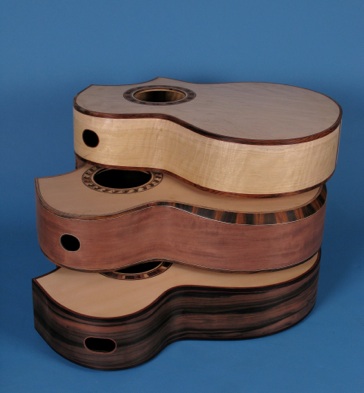
These “traditional” design features in acoustic guitars have been putting food on the tables of guitar repair technicians for many decades now.
The intrinsic strength of a slightly domed top will largely negate this type of distortion, particularly if the bracing underneath is also designed to provide stability where it is most needed. For more on this topic, see Soundboard Bracing and Tuning.
I also believe that coupling a radiused top with a radiused back will promote a more lively and energetic excursion of sound waves between the plates, than if the top starts out as as a flat plane. I’m not an acoustic engineer, but my gut tells me that curved surfaces facing each other will reflect sound waves more omni-directionally, preventing standing waves, which just bounce back and forth inside the box, and don’t really go anywhere. Standing waves inside the soundbox are what causes a boomy, woofy, or generally unfocused tone. At least, that’s my experience.
Another departure I have taken from traditional steel-string sound box design is, the waist area is actually the deepest part of the structure, instead of the lower bout, as seen on the vast majority of acoustic guitars. Every Edwinson guitar ever built has a deeper waist, tapering shallower in the upper and lower bouts. My reasons for doing it this way are for both good sound production and comfortable ergonomics.
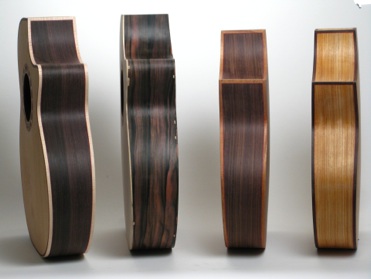
The photo at left shows this unusual body shape.
With a shallower lower bout, tapering wider toward the waist, I think the sound waves will want to project more to the center of the sound box, making air movement and sound projection at the sound hole more dynamic and energetic. I’ve made dozens of guitars this way, and have never experienced woofy, boomy, unfocused sound, or a lack of bass response or volume. Quite the contrary, in fact. I find it easier to make a sound box that produces a lot of high-quality sound, and very even response from bass, to midrange, to the upper trebles. I firmly believe that this sound box design contributes to great clarity, balance, projection, and volume.
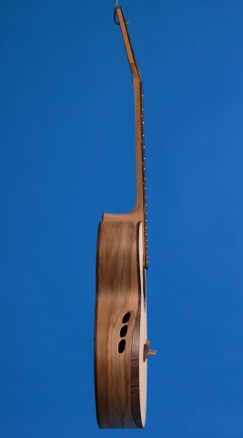
Several years ago, I had a torn rotator cuff in my right shoulder, and I just couldn’t play my good old 1972 Yairi dreadnaught, with its five inch deep lower bout, without major discomfort. But I could play my Edwinson EPS without aggravating the shoulder.
To my way of thinking, playing guitar should be a pleasurable experience; otherwise, what’s the point?
The guitar at left is a 2013 EP Performance Florentine, my largest model. With its Edwinson body taper, and an arm bevel, it feels like a smaller guitar when you hold it. Very comfortable and intimate.
If you do a side-by-side comparison of this guitar and a standard dreadnaught, you’ll be amazed at how much more comfortable the Edwinson is to hold and play.
Fundamentally, the acoustic guitar soundbox is an air pump, which is activated by the energy of vibrating strings, played under tension. To produce sound, the air volume inside the soundbox must be excited by a focused, percussive force , a pick, a strum, the energy of strings in play.
Further, the geometry and architecture of the soundbox should be designed in such a way as to to shepherd the air movement within this acoustic chamber into pleasing and articulate projections of musical sound. That is the distillation of all the reasons for the guitar’s form and function. All of Music devolves to the movement of air. Music is the reason to move the air. This is what we hear. We are marked by this experience.
This is the place where the science and magic of the acoustic guitar live, in harmony and symbiosis.
There are myriad variables that go into play with every iteration of soundbox design. Our job as luthiers is to combine science, intellect, educated judgement, and intuition into the search for the golden mean, as we strive to build the most efficient, fluent, and articulate air pumps that our skills and instincts will allow.
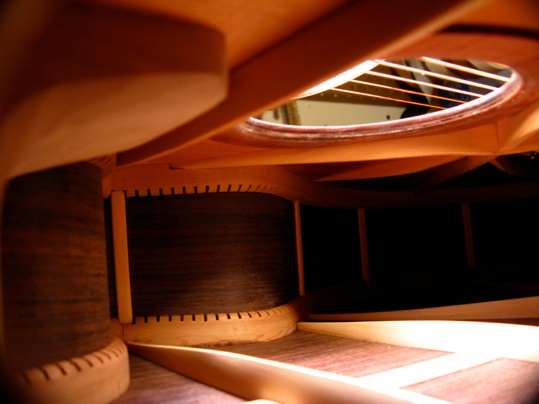
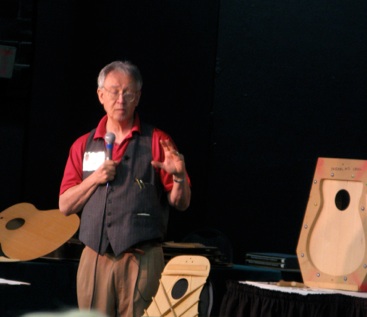
This concept is elucidated brilliantly by Master Guitar Maker and Professor of American Lutherie, Ervin Somogyi , in his 2009 book, The Responsive Guitar, which is absolutely essential reading for anyone who is interested in the finer points of acoustic guitar design philosophy, and its practice and trade wisdom, in the hands of a Master.
The photo at left is Ervin, explaining these mysterious arcana in his lecture at the 2009 Healdsburg Guitar Festival.